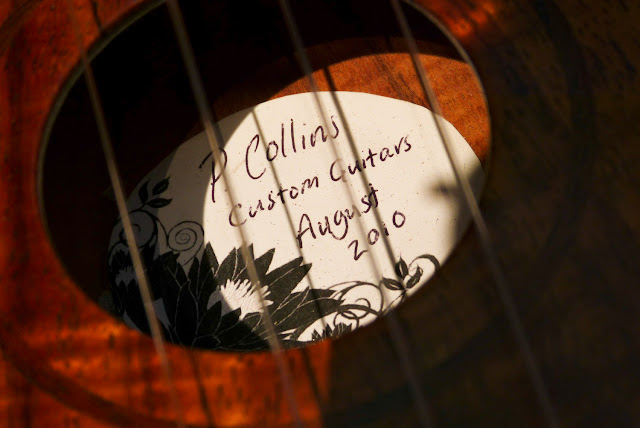2010 Phil Collins Koa Concert Ukulele
Phil Collins is a guitar builder out of London, England and, apparently, this was his graduation build as he exited an acoustic makers' course in 2010. It's unapologetically gorgeous with the intensely-flamed Hawaiian koa that's used throughout, though when it came in it did have a few "early builder" quirks. It's a concert-sized instrument with a 15 1/8" scale length, 7 5/8" lower bout width, and 2 1/2" depth. As noted, the uke is entirely made from flamed koa save for the binding, fretboard, rosette, and bridge which look like rosewood to me. The neck is mahogany and the nut and saddle are bone.
My own work on this instrument included leveling and dressing the frets (they weren't seated quite right), adjusting the saddle and nut heights, adding a set of tuners (nothing was on it when it arrived), and filling the original string-mount slots and converting this to a "string-through-bridge" setup, instead. That last bit is because the slots weren't cut in the right places and so the strings weren't aligned with the neck. The top is also braced fairly stiff and so I wanted to get a lot of back-angle on the saddle, too, for better tone. The current (fluorocarbon) strings on it could definitely be jumped-up to something like Worth heavies/fats, too, but it has a bright, sparkly tone as-is. Action is spot-on at 1/16" at the 12th fret and the neck is straight -- though the fretboard extension dips down over the body just a hair.
This has a hand-done "Danish oil"-type finish and, while the open pores of the wood are visible when you glance the light off of it, it does pop the grain out in this beautiful koa like crazy. It's a gloss look, too.
The new tuners are Golden Gate friction pegs and they work great. The nut is 1 1/2" in width and the back of the neck has a medium D-shaped profile.
The fretboard has a light radius to it. I also forgot that I added fret dots at 5, 7, and 9.
To string this, one runs the string through the hole, pulls it out the soundhole, knots it into a ball on the "soundhole end," and then pulls it back snug and up to the tuner. It's a tidy way to string and very secure, too. I run the new holes at an angle so the string wants to point towards the soundhole when it goes into the body, too.


















Comments